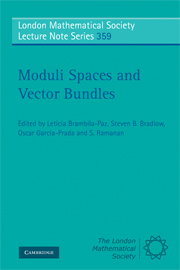Book contents
- Frontmatter
- Contents
- Preface
- Acknowledgments
- Part I Lecture Notes
- 1 Lectures on Principal Bundles
- 2 Brill-Noether Theory for Stable Vector Bundles
- 3 Introduction to Fourier-Mukai and Nahm Transforms with an Application to Coherent Systems on Elliptic Curves
- 4 Geometric Invariant Theory
- 5 Deformation Theory for Vector Bundles
- 6 The Theory of Vector Bundles on Algebraic Curves with Some Applications
- Part II Survey Articles
- Part III Research Articles
1 - Lectures on Principal Bundles
Published online by Cambridge University Press: 07 September 2011
- Frontmatter
- Contents
- Preface
- Acknowledgments
- Part I Lecture Notes
- 1 Lectures on Principal Bundles
- 2 Brill-Noether Theory for Stable Vector Bundles
- 3 Introduction to Fourier-Mukai and Nahm Transforms with an Application to Coherent Systems on Elliptic Curves
- 4 Geometric Invariant Theory
- 5 Deformation Theory for Vector Bundles
- 6 The Theory of Vector Bundles on Algebraic Curves with Some Applications
- Part II Survey Articles
- Part III Research Articles
Summary
To Peter Newstead on his 65th birthday
Introduction
The aim of these lectures is to give a brief introduction to principal bundles on algebraic curves towards the construction of the moduli spaces of semistable principal bundles. The second section develops the basic machinery on principal bundles and their automorphisms. At the end of the second section, we give a proof of theorem of Grothendieck on orthogonal bundles. The third section, after developing the notions of semistability and stability, gives a modern proof of the main part of Grothendieck's theorem on classification of principal bundles on the projective line. The last section gives an outline of the construction of the moduli space of principal bundles on curves. The moduli space was constructed by A.Ramanthan in 1976. The method outlined here is from a construction in [BS]. These notes are a transcription of the lectures given in Mexico and therefore have an air of informality about them. I have consciously retained this informality despite criticism from a learned referee on the lack of rigor in some places. Indeed “these notes are almost exactly in the form in which they were first written and distributed: as class notes, supplementing and working out my oral lectures. As such, they are far from polished and ask a lot of the reader. …Be that as it may, my hope is that a well-intentioned reader will still be able to penetrate these notes and learn something of the subject”
- Type
- Chapter
- Information
- Moduli Spaces and Vector Bundles , pp. 2 - 28Publisher: Cambridge University PressPrint publication year: 2009
- 4
- Cited by



